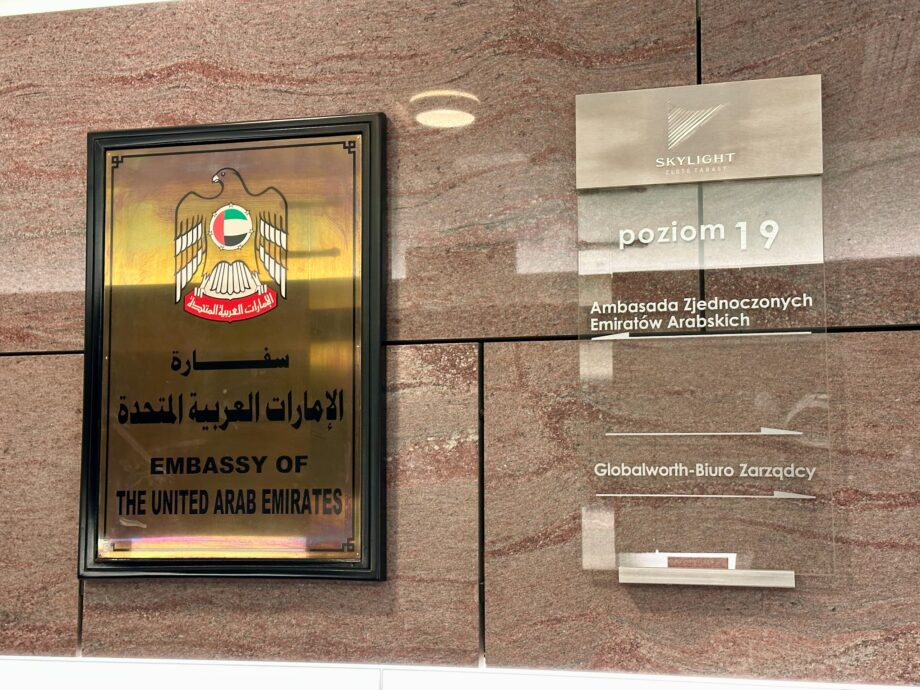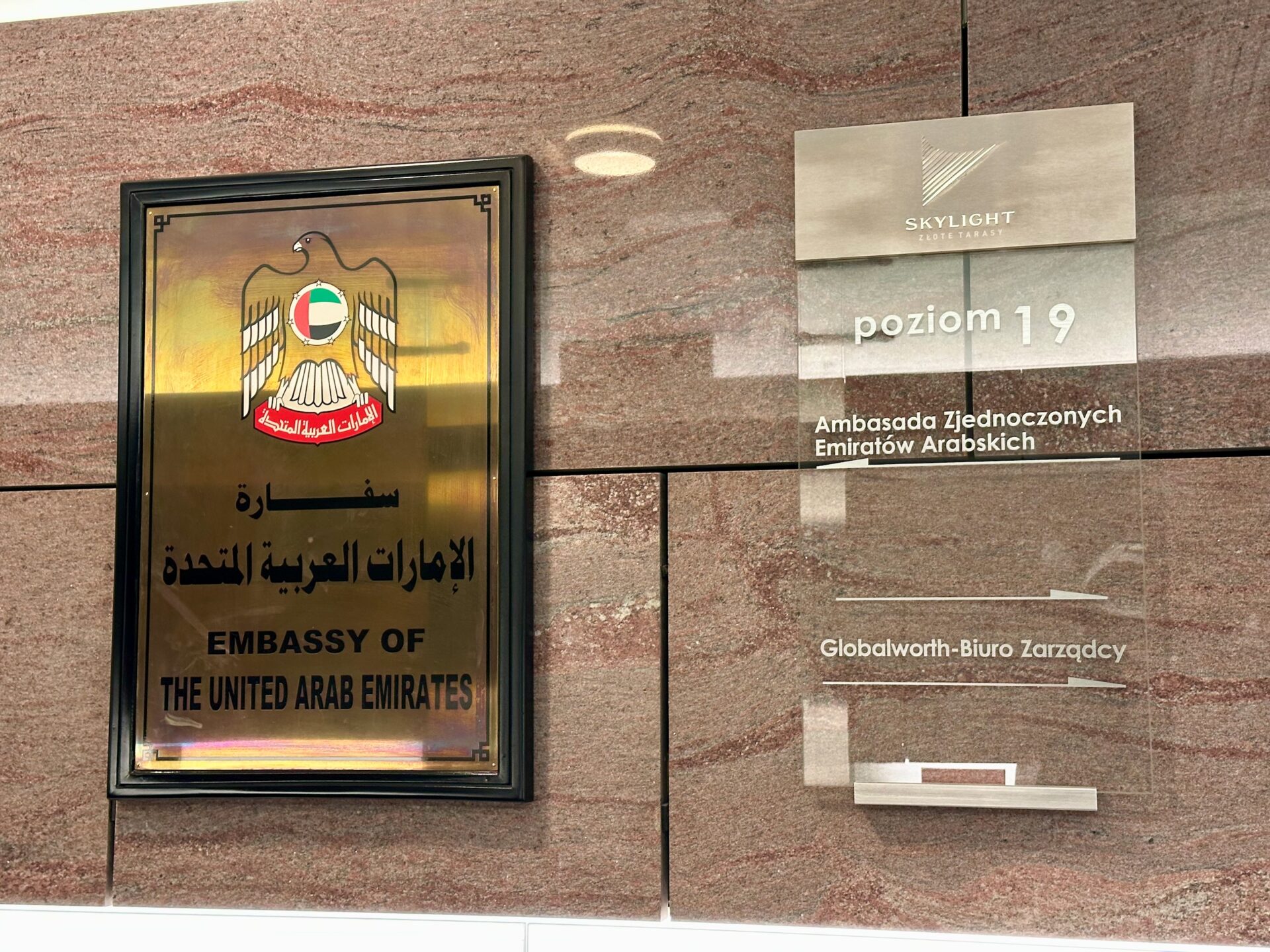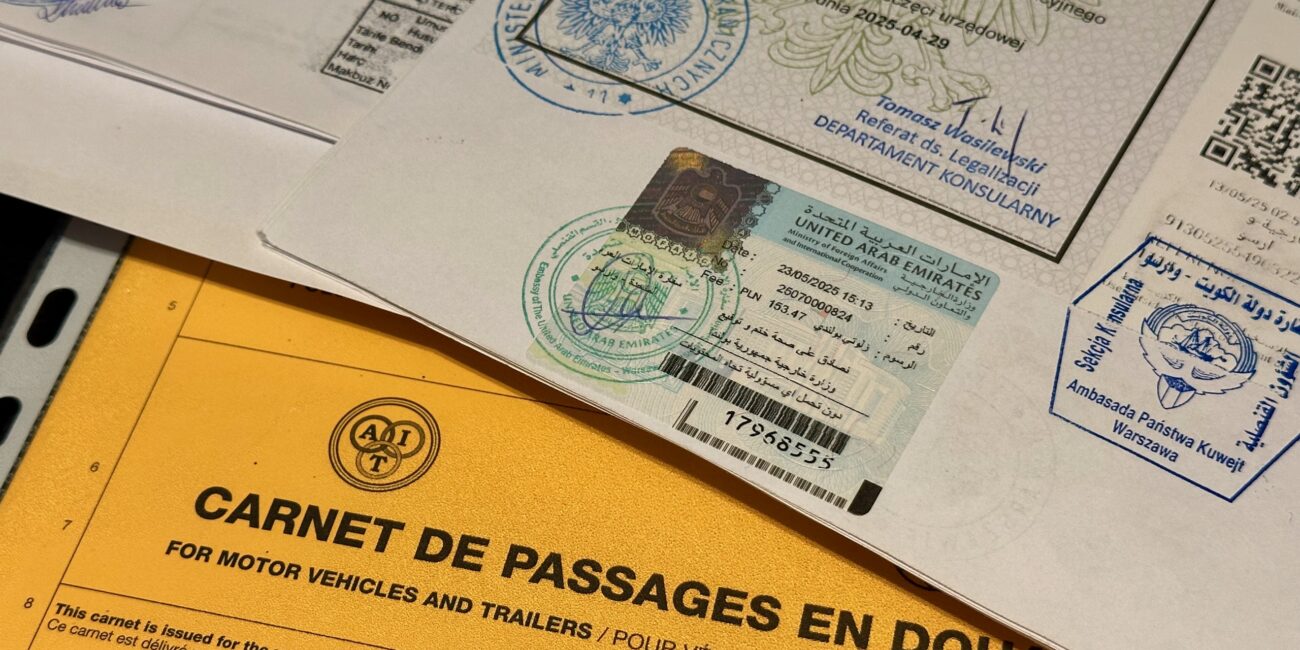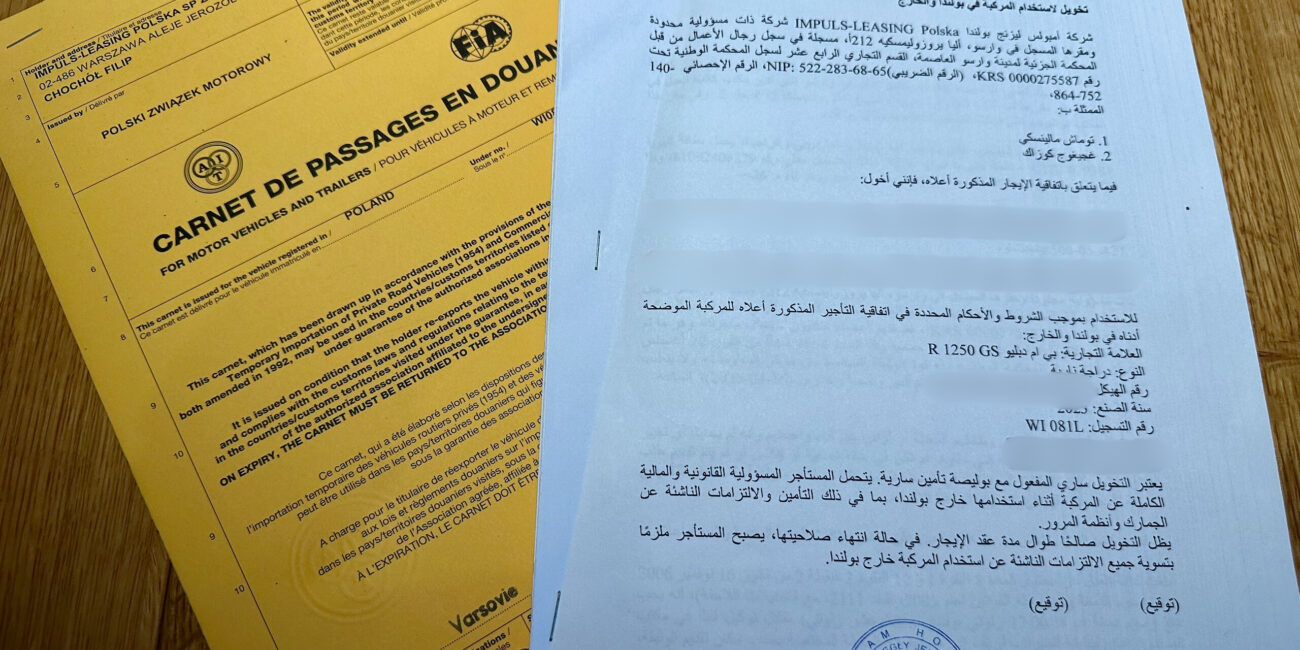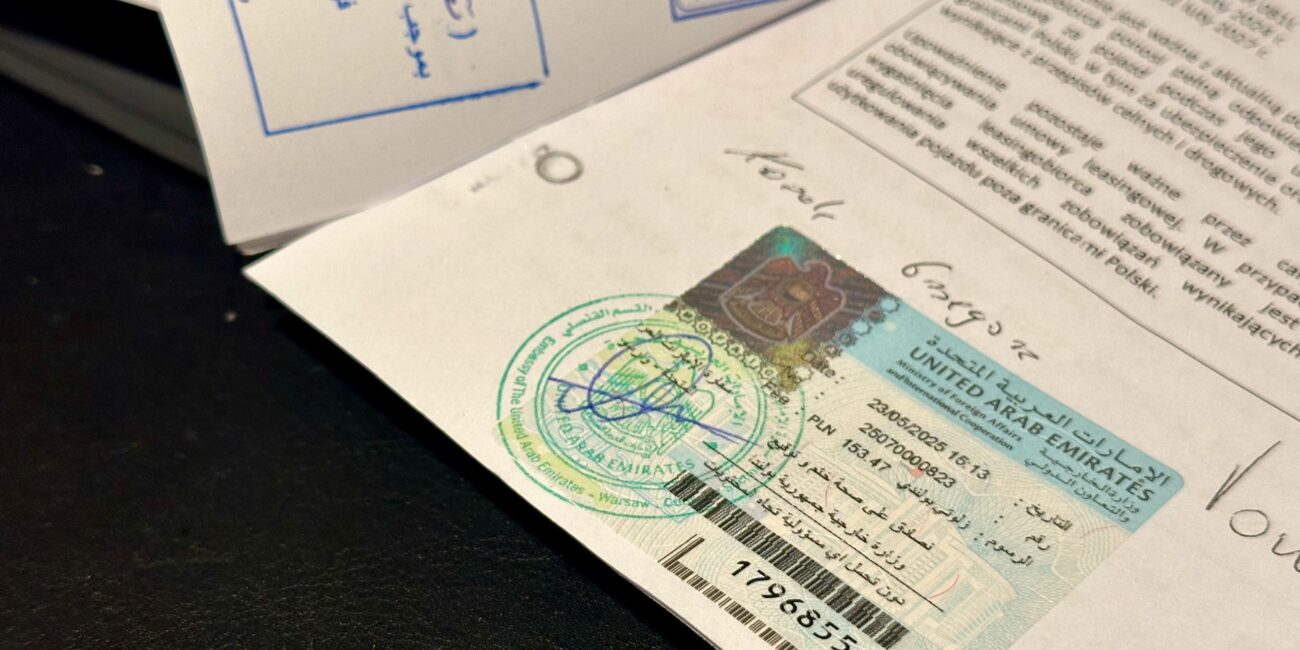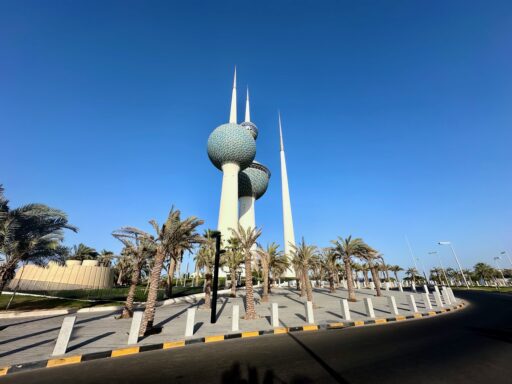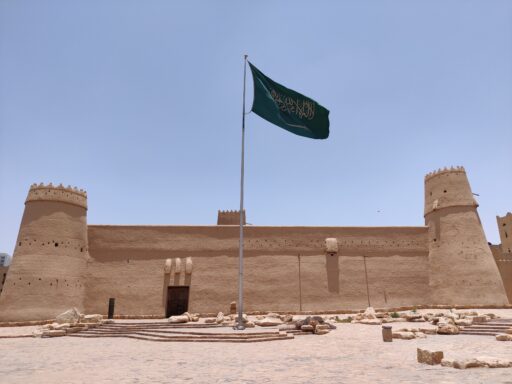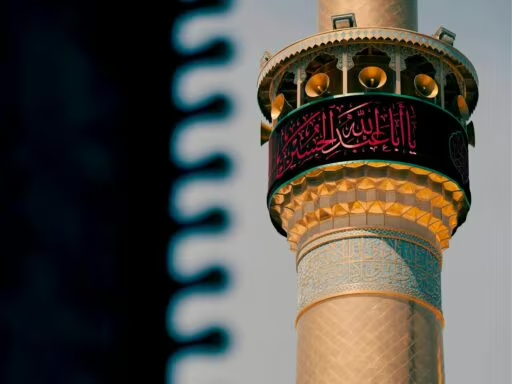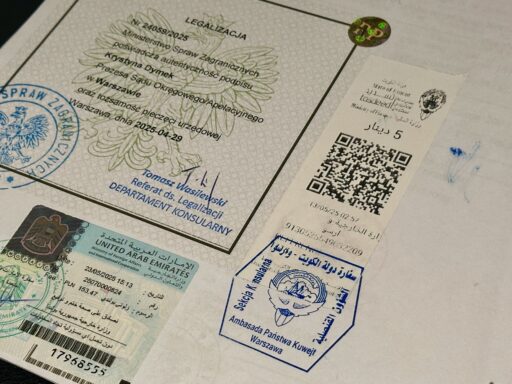This post is also available in:
Polski
Hello! 👋
After a few days of chasing papers through courts, the Ministry of Foreign Affairs and various embassies, we finally reached the last stop on our legalization journey – the United Arab Emirates. This was where we wrapped everything up before crossing into Oman.
This time things were a bit easier – most of the paperwork was already prepared, but it still needed some extra legalization. In this post, we’ll walk you through how we handled the process for the UAE and what’s worth paying special attention to if you’re heading there with a leased vehicle.
Are leasing documents checked in the Emirates?
Crossing into the UAE with a leased vehicle isn’t based on assumptions — border officials really do check the paperwork, especially if the vehicle is still owned by a leasing company. Since leasing means you’re only the user, not the owner, they require a clearly documented owner’s consent (from the leasing company), backed by a notarized authorization and a full legalization process through the Ministry of Foreign Affairs and the UAE Embassy.
Documents worth having at the border
Here’s a list of the essential documents you’ll definitely want to have when entering the UAE with a leased vehicle (plus a few of our own tips):
- vehicle registration certificate,
- passport + tourist visa for the United Arab Emirates – Polish citizens receive it free of charge at the border in the form of a stamp (valid for 90 days),
- a notarised authorisation from the leasing company, translated into Arabic by a sworn translator and legalised by the Polish Ministry of Foreign Affairs and the UAE Embassy in Warsaw,
- Carnet de Passages – for land entry into the UAE, this document is formally required, as the UAE is part of the CPD system,
- a copy of the leasing agreement – just in case; if needed, it can be quickly translated using DeepL or ChatGPT,
- photocopies of all documents – keep them separate from the originals; in case of theft, they will speed up the formalities.
Regarding vehicle insurance – entering the UAE with your own vehicle requires valid third-party liability coverage recognized in the Emirates. Since Polish OC and the Green Card do not apply there, you must purchase border insurance – either on the spot (e.g., at the Al Ghuwaifat or Hatta border crossings) or in advance via the UAE Aber online system.
Notarized authorization from the lessor – how to obtain it
A leased motorcycle legally belongs to the leasing company, so you can’t take it abroad without their written consent. If your contract contains no clauses restricting travel outside the EU, that’s a good sign — but in practice, much depends on the company’s policy. Some will issue the document within a few days, while others are more cautious, especially since entering the UAE often involves transiting through Iraq, which the Polish Ministry of Foreign Affairs classifies as a high-risk destination.
The key is to have a clear statement in the authorization confirming that you’re allowed to drive the vehicle outside Poland — ideally without territorial limits, or with an explicit list of the countries in the region.
The document should be signed by a person authorized to represent the company (a board member or proxy) in the presence of a notary. The notarial fee is PLN 24.60 gross per signature. It’s worth requesting several copies right away — keep the original in a safe place and use the others for the next stages of legalization.
Court and Ministry of Foreign Affairs – completing Polish seals
After leaving the notary, head to the competent District Court to certify the notary’s signature. This step is mandatory — without this stamp, the Ministry of Foreign Affairs will not accept the document for further processing.
The next stop is Polish Ministry of Foreign Affairs (MSZ) at 38/42 Krucza Street in Warsaw. Here you’ll get the “Polish” authentication: legalisation (26 PLN per document) and—if you also want to use the same copy in Hague Convention countries such as Oman or Saudi Arabia—you can add an apostille on the same copy (60 PLN). Payments are made in advance, and you book the appointment online; in person, the document is usually issued on the spot, while postal submissions require a few extra days.
It is worth knowing that there are two types of document authentication at the Ministry of Foreign Affairs:
- legalization – for countries outside the apostille system (e.g. Kuwait, UAE, Iraq),
- apostille – for countries that have signed the Hague Convention (e.g. Oman, Saudi Arabia).
Important for the UAE: The Emirates are not a party to the Hague Convention, so an apostille alone won’t work there—the key step is consular legalisation, as described above. You might only add an apostille “on the side” if you plan to use the same copy in other countries in the region that accept it (e.g., Saudi Arabia or Oman). At this stage, you’ll have all the necessary Polish seals and can take the document to a sworn translator.
Sworn translation
Once your document has the full set of Polish stamps from the MFA (legalisation and—if you opted for it—apostille), the best next step for the UAE and other countries in the region is to hand it over to a sworn Arabic translator.
From our own experience, we can recommend Dr Adam Hosin, who has handled translations for us used in legalisations and apostilles across the Middle East. The market rate for such a translation is usually between 300 and 600 PLN net, depending on the length of the text. Importantly, the translator immediately binds the translation together with the original (including all Polish stamps) and seals the entire set.
This is important because the consulates of the UAE, Kuwait, and Iraq do not accept standalone translations – the document must be a single, permanently bound package.
Embassy of the United Arab Emirates
Before heading to the UAE embassy, you’ll need to visit the Polish Ministry of Foreign Affairs again – this time to legalize the sworn translation (treated as a separate document). Yes, even if it’s already bound together with the original.
Keep in mind that everything is based on the same original document, on which you’ll be collecting stamps and legalizations from each embassy. However, if you plan to cover more than three countries in the region, consider preparing an additional copy with its own legalization — you might simply run out of space for all the seals on a single version.
We did our “embassy circuit,” leaving the UAE for last. Once the translation was legalized at the MFA (and apostilled as well, if Oman or Saudi Arabia were on the list), the next stop was the Consular Section of the UAE Embassy in Warsaw, located at Złota 59 (SkyLight Tower, 19th floor – right next to Złote Tarasy shopping center).
Here’s a small surprise – the consulate doesn’t legalize just the translation. If your document carries more than one Polish MFA legalization (for example, the court authentication and the translation), you’ll be charged for each one separately. The fee is 150 AED per item, payable by card on the spot.
The processing time is usually up to 5 working days. It may feel like “just another way to make extra money,” but unfortunately, without these stamps, entering the UAE with a leased vehicle might not be possible.
How to simplify the procedure and avoid stress
The easiest way? Buy the vehicle out of the lease — then you just travel with a registration certificate showing your name, and that’s the end of the story. All the procedures we’ve described — whether for Turkey, Iraq, Kuwait, or the UAE — apply only when the vehicle is still legally owned by the leasing company. And it’s precisely the fact that it’s not yours that creates all this paperwork.
The procedure for the UAE is manageable as long as you stay organized. In the best-case scenario — with a fast sworn translator, no queues at the Ministry of Foreign Affairs, and a smooth visit to the embassy — you can wrap everything up in about two weeks. In reality, especially during the holiday season, it’s safer to plan for around a month.
It’s also worth remembering that the UAE embassy does not verify the content of your document — it only confirms the authenticity of previous stamps (notary, court, Ministry of Foreign Affairs, translator). In theory, you might encounter a border officer who asks for additional paperwork, but if you have a complete and properly prepared set, the risk of any issues is minimal.
We prefer to take care of all the paperwork in Poland rather than try to explain ourselves at the border.
If you also don’t have time to run around offices, you can reach out to us via the contact form on our blog — we can walk you through the process step by step or handle it on your behalf.
See you on the road! 🗺️ 🏍️

